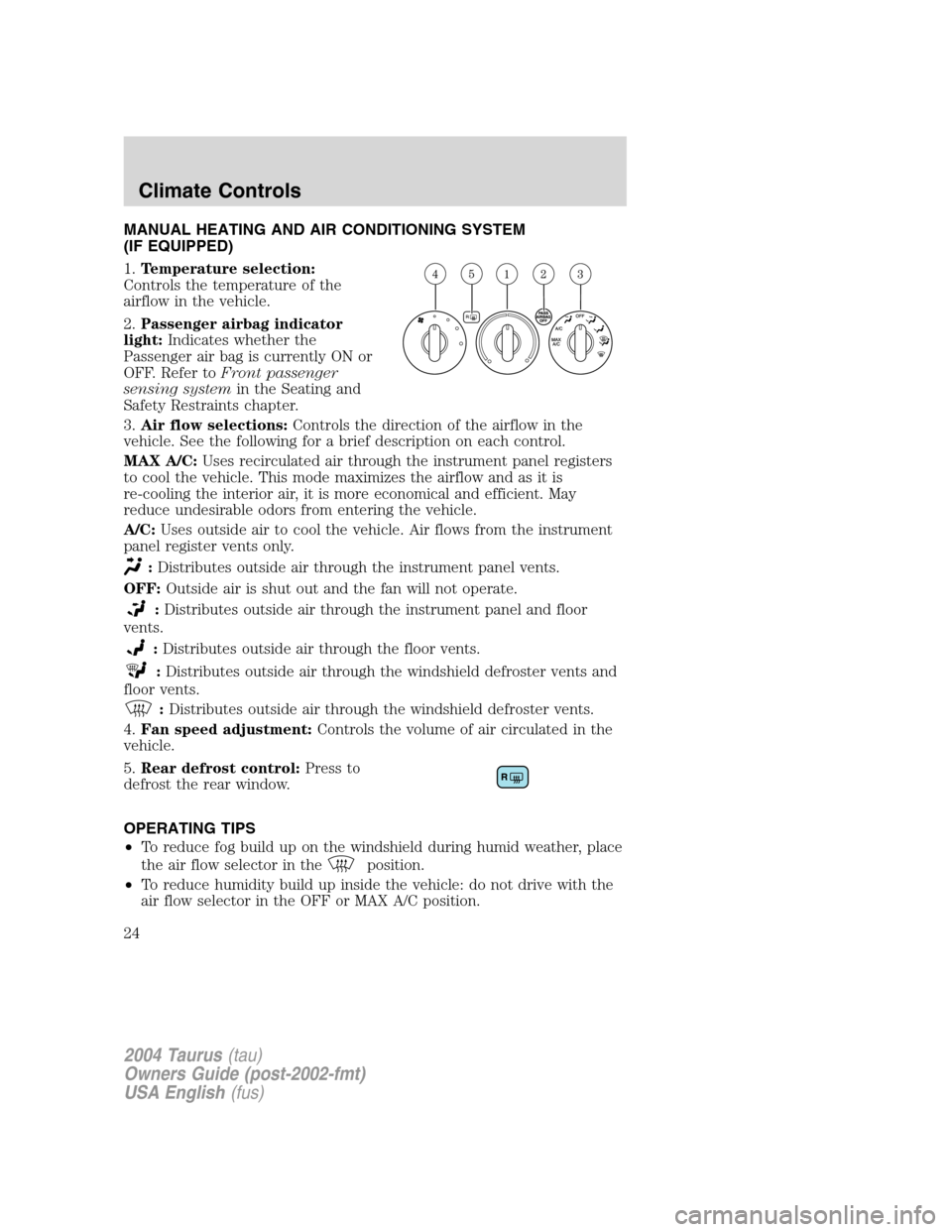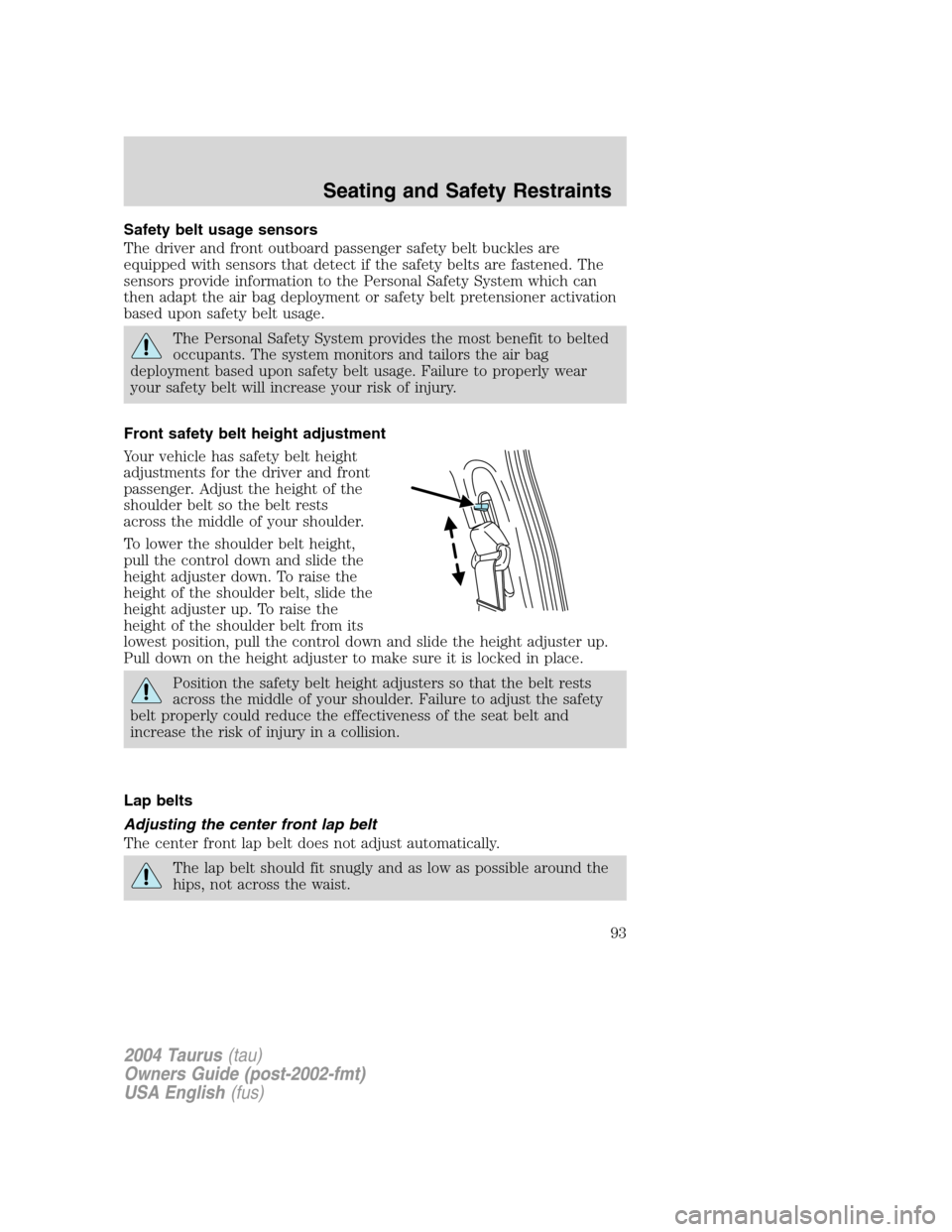2004 FORD TAURUS seat adjustment
[x] Cancel search: seat adjustmentPage 24 of 240

MANUAL HEATING AND AIR CONDITIONING SYSTEM
(IF EQUIPPED)
1.Temperature selection:
Controls the temperature of the
airflow in the vehicle.
2.Passenger airbag indicator
light:Indicates whether the
Passenger air bag is currently ON or
OFF. Refer toFront passenger
sensing systemin the Seating and
Safety Restraints chapter.
3.Air flow selections:Controls the direction of the airflow in the
vehicle. See the following for a brief description on each control.
MAX A/C:Uses recirculated air through the instrument panel registers
to cool the vehicle. This mode maximizes the airflow and as it is
re-cooling the interior air, it is more economical and efficient. May
reduce undesirable odors from entering the vehicle.
A/C:Uses outside air to cool the vehicle. Air flows from the instrument
panel register vents only.
:Distributes outside air through the instrument panel vents.
OFF:Outside air is shut out and the fan will not operate.
:Distributes outside air through the instrument panel and floor
vents.
:Distributes outside air through the floor vents.
:Distributes outside air through the windshield defroster vents and
floor vents.
:Distributes outside air through the windshield defroster vents.
4.Fan speed adjustment:Controls the volume of air circulated in the
vehicle.
5.Rear defrost control:Press to
defrost the rear window.
OPERATING TIPS
•To reduce fog build up on the windshield during humid weather, place
the air flow selector in the
position.
•To reduce humidity build up inside the vehicle: do not drive with the
air flow selector in the OFF or MAX A/C position.
2004 Taurus(tau)
Owners Guide (post-2002-fmt)
USA English(fus)
Climate Controls
Climate Controls
24
Page 90 of 240

2. To unfasten, push the release
button and remove the tongue from
the buckle.
Energy management retractors
Your vehicle has a seat belt system equipped with energy management
retractors at the driver and front outboard passenger seating positions.
An energy management retractor is a device which pays out webbing in a
controlled manner. This feature is designed to help further reduce the
risk of force-related injuries to the occupant.
Seat belt systems equipped with an energy management retractor must
be replaced if they were in use during a frontal collision which resulted
in deployment of the frontal air bags. Refer to theSafety belt
maintenancesection in this chapter.
Vehicle sensitive mode
This is the normal retractor mode, which allows free shoulder belt length
adjustment to your movements and locking in response to vehicle
movement. For example, if the driver brakes suddenly or turns a corner
sharply, or the vehicle receives an impact of approximately 8 km/h (5
mph) or more, the combination safety belts will lock to help reduce
forward movement of the driver and passengers.
Automatic locking mode
In this mode, the shoulder belt is automatically pre-locked. The belt will
still retract to remove any slack in the shoulder belt. The automatic
locking mode is not available on the driver safety belt.
This mode should be usedany timea child safety seat is installed in the
vehicle. Children 12 years old and under should be properly restrained in
the rear seat whenever possible. Refer toSafety restraints for children
orSafety seats for childrenlater in this chapter.
2004 Taurus(tau)
Owners Guide (post-2002-fmt)
USA English(fus)
Seating and Safety Restraints
90
Page 93 of 240

Safety belt usage sensors
The driver and front outboard passenger safety belt buckles are
equipped with sensors that detect if the safety belts are fastened. The
sensors provide information to the Personal Safety System which can
then adapt the air bag deployment or safety belt pretensioner activation
based upon safety belt usage.
The Personal Safety System provides the most benefit to belted
occupants. The system monitors and tailors the air bag
deployment based upon safety belt usage. Failure to properly wear
your safety belt will increase your risk of injury.
Front safety belt height adjustment
Your vehicle has safety belt height
adjustments for the driver and front
passenger. Adjust the height of the
shoulder belt so the belt rests
across the middle of your shoulder.
To lower the shoulder belt height,
pull the control down and slide the
height adjuster down. To raise the
height of the shoulder belt, slide the
height adjuster up. To raise the
height of the shoulder belt from its
lowest position, pull the control down and slide the height adjuster up.
Pull down on the height adjuster to make sure it is locked in place.
Position the safety belt height adjusters so that the belt rests
across the middle of your shoulder. Failure to adjust the safety
belt properly could reduce the effectiveness of the seat belt and
increase the risk of injury in a collision.
Lap belts
Adjusting the center front lap belt
The center front lap belt does not adjust automatically.
The lap belt should fit snugly and as low as possible around the
hips, not across the waist.
2004 Taurus(tau)
Owners Guide (post-2002-fmt)
USA English(fus)
Seating and Safety Restraints
93
Page 233 of 240

Cleaning your vehicle
engine compartment ..............172
instrument panel ....................174
interior .....................................174
interior trim ............................175
plastic parts ............................173
washing ....................................171
waxing .....................................171
wheels ......................................172
wiper blades ............................174
Climate control (see Air
conditioning or Heating) ............25
Clock adjust
AM/FM Stereo ...........................15
AM/FM/CD .................................19
AM/FM/Tape ..............................19
Compass, electronic
set zone adjustment .................56
Console ........................................52
Controls
power seat .................................83
Coolant
checking and adding ..............187
refill capacities ................190, 221
specifications ..................222, 224
Cruise control
(see Speed control) ....................49
Customer Assistance ................142
Ford accessories for your
vehicle .....................................176
Ford Extended Service
Plan ..........................................164
Getting assistance outside the
U.S. and Canada .....................168
Getting roadside assistance ...142
Getting the service you
need .........................................162
Ordering additional owner’s
literature .................................169The Dispute Settlement
Board .......................................164
Utilizing the
Mediation/Arbitration
Program ...................................167
D
Daytime running lamps
(see Lamps) ................................29
Defrost
rear window ..............................28
Dipstick
automatic transmission
fluid ..........................................204
engine oil .................................182
Doors
lubricant specifications ..........222
Driving under special
conditions ..................................134
through water .........................134
E
Electronic message center .........53
Emergencies, roadside
jump-starting ..........................156
Emergency Flashers .................143
Emission control system ..........200
Engine ........................................224
cleaning ...................................172
coolant .....................................187
idle speed control ...................185
lubrication
specifications ..................222, 224
refill capacities ........................221
service points ..................179–180
starting after a collision .........143
Engine block heater .................126
2004 Taurus(tau)
Owners Guide (post-2002-fmt)
USA English(fus)
Index
233